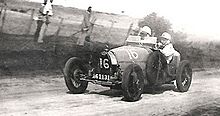
Back Bugatti Type 35 Czech Bugatti Type 35 German Bugatti Type 35 Spanish بوگاتی تیپ ۳۵ Persian Bugatti Type 35 French Bugatti Type 35 Galician Bugatti Tipo 35, 37 e 39 Italian ブガッティ・タイプ35 Japanese 부가티 타입 35 Korean Bugatti Type 35 Dutch
| Bugatti Type 35 | |
|---|---|
 | |
| Overview | |
| Manufacturer | Automobiles Ettore Bugatti |
| Production | 1924–1930 |
| Assembly | France: Molsheim-Dorlisheim, Alsace (Usine Bugatti de Molsheim) |
| Designer | Ettore Bugatti |
| Body and chassis | |
| Class | Grand Prix, Formula Libre |
| Body style | Underslung Type |
| Layout | FR |
| Chassis | Steel ladder frame, aluminum body |
| Powertrain | |
| Engine |
|
| Transmission | 4-speed manual + reverse |
| Dimensions | |
| Wheelbase | 2,400 mm (94.5 in) |
| Length | 3,680 mm (144.9 in) |
| Width | 1,320 mm (52.0 in) |
| Curb weight | 650–750 kg (1,435–1,655 lb) |
| Chronology | |
| Predecessor | Bugatti Type 30 |
| Successor | Bugatti Type 51 |


The Bugatti Type 35 is an iconic race car design produced by Bugatti at their Molsheim premises between 1924 and 1930. It was extremely successful when raced by the factory works team. It was also bought by a diverse roster of privateer clientele from around the world. It pioneered the concept of a holistically conceived, race-ready car available for purchase.
The arch/egg-shaped[1] radiator is emblematic, as is the rear of the car. The tapered stern has been called a 'Bordino tail' and Ettore Bugatti may have been influenced by the shape of the earlier Fiat 804 driven and modified by Pietro Bordino.[2] The car has also become synonymous with being the first to use cast alloy wheels.[3][4]
The Type 35 was phenomenally successful, winning over 1,000 races in its time. It took the Grand Prix World Championship in 1926 after winning 351 races and setting 47 records in the two prior years. At its height the Type 35 averaged 14 race wins per week. Bugatti won the Targa Florio for five consecutive years, from 1925 through 1929, with the Type 35.[5]
The Bugatti Type 35 was continually being modified and improved upon, but broadly falls into the following nomenclature:
- ^ "Bugatti design – a legend about eggs and horseshoes" (Press release). Molsheim: Bugatti. 2019-04-18. Retrieved 2023-02-12.
- ^ Conway, Hugh (1983). Grand Prix Bugatti (Revised ed.). Haynes Publishing Group. p. 45. ISBN 0 85429 293 4.
- ^ Conway, Hugh (1983). Grand Prix Bugatti (Revised ed.). p. 48. ISBN 0 85429 293 4.
- ^ Petrány, Máté (2019-10-08). "Ettore Bugatti made alloy wheels a thing". Hagerty. Retrieved 2023-02-12.
- ^ "The legendary Bugatti Type 35". Bugatti. Archived from the original on 2020-09-29. Retrieved 2021-10-25.
© MMXXIII Rich X Search. We shall prevail. All rights reserved. Rich X Search